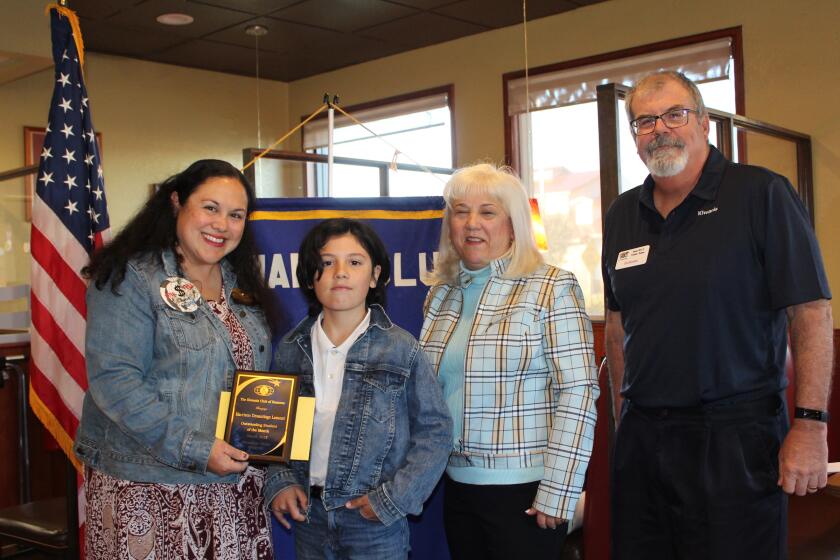Regional agency’s report targets recycled water inequities, Montecito sewer
By Joe Naiman
In its approval of the service review and sphere of influence update for the Ramona Municipal Water District (RMWD), San Diego County’s Local Agency Formation Commission (LAFCO) asked its staff to return in six to 12 months with a report on equity involving the San Vicente Wastewater Service Area and recycled water, and on sanitation plans for the Montecito Ranch development.
“We’re basically adopting this report and the findings of this report,” San Diego County Supervisor Dianne Jacob, who sits on the LAFCO board, said at the June 2 meeting.
RMWD directors accepted the report at their June 10 meeting, with Director Joe Zenovic calling the report “terrific” and General Manager David Barnum saying LAFCO members gave favorable comments about the board. The board also authorized President Darrell Beck to sign a multi-party letter to LAFCO that re-affirms the ongoing partnership between the district, San Diego Country Estates Association (SDCEA) and Spangler Peak Ranch for recycled water.
LAFCO’s periodic review evaluates services and anticipated needs.
“They’re LAFCO’s opportunity to do something more than review boundaries,” LAFCO executive officer Mike Ott said.
A sphere of influence study determines boundaries best served by an agency. The last approved review and sphere of influence update for RMWD was in 2007.
Several concerns were raised in June 2013, when LAFCO reviewed a preliminary version of the service review and sphere of influence update. Concerns about governance included communications and transparency to the community.
Customers in the service area of the San Vicente treatment plant pay the full amount for maintenance and operations but receive only part of the discounted recycled water. The Spangler Peak Ranch grove is within the water district boundaries but outside the sewer service area, so it does not pay for maintenance or operations. However, it receives discounted water at the same price as San Diego Country Estates and Rancho San Vicente homeowners.
The San Vicente plant was part of the San Diego Country Estates development and originally included spray field disposal, but, due to an adjacent landowner’s opposition, the location of the treatment plant was moved. In 1985, the spray field disposal was replaced with an agreement to supply recycled water to Spangler Peak Ranch.
In 2007, the district and Spangler Peak joined the Estates association in approving a 10-year contract to provide the Estates with half that water at the same rate of $35 per acre-foot. Per year, Spangler Peak receives 284.5 acre-feet while the Estates’ San Vicente golf course receives 293.1 acre-feet.
The rest of the water needs for the Estates and Rancho San Vicente are met by the sale of potable water at the RMWD rate. The approximately 3,500 Estates homeowners and 241 Rancho San Vicente homeowners pay an annual sewer operations and maintenance charge of $662.
“I think it’s unfair for Spangler Peak Ranch to get such a discount on recycled water, and people in San Diego Country Estates are paying for that,” Jacob said. “It’s an injustice that’s taking place.”
Individual Estates ratepayers expressed dismay at the inequity at the LAFCO hearing.
However, at the Ramona water district’s June 10 meeting, Doug Kafka, president of the SDCE homeowner’s association, said he was frustrated that there were some people in the Estates who wish to speak for the entire development regarding recycled water.
“It’s our sincere desire to continue this contract as it is written,” Kafka told the water board.
Because LAFCO’s purview only includes jurisdictional boundaries, Jacob noted that the agency likely could not address the inequity of Spangler Peak Ranch’s discount at the expense of the Estates and Rancho San Vicente.
LAFCO board member John Ingalls suggested the entire sewer service area be converted into a Community Services District.
“In terms of regionalizing sewer service, I think there is a great benefit,” Ott said. “However, it would be a tree-hugger’s dream of litigation.”
Ott suggested LAFCO could review the situation before the subsequent update. Ott also noted that, while LAFCO could create a Community Services District to replace the RMWD sewer service area, a citizen-initiated petition could not remove sewer service alone, but would require detachment from the entire water district along with creation of a replacement special district.
For the planned Montecito Ranch that will include 417 homes northeast of Ramona Airport, the cost of the water district’s connection fees led developers to propose a Community Services District for on-site wastewater treatment rather than annexation into the Ramona MWD sewer latent powers area. Either option would need LAFCO approval.
County supervisors approved Montecito Ranch in 2010 with the condition that it be in a Community Services District or added to RMWD’s Santa Maria sewer service area. Montecito Ranch representatives have been working with the water district, and cost of service studies that are under way may reduce the connection fees. A Community Services District with no population at the time of creation would initially be a dependent special district with the county supervisors serving as the governing board. Once 300 registered voters live within that special district, the voters can petition to convert it to an independent special district with a locally-elected board.
LAFCO’s staff report will update the commission on options for Montecito Ranch and for the San Vicente sewer service area.
“Something needs to happen, and it needs to happen quickly,” Jacob said.
The Ramona water district held meetings at 4 p.m. when Kit Kesinger was elected to the board, but the shift to 2 p.m. meetings was incompatible with Kesinger’s full-time job and he has been absent from the meetings. Rex Schildhouse has also missed several meetings.
“We have some grave concerns that the Ramona Municipal Water District has been operating without a fully functioning board,” said LAFCO special districts advisory committee vice-chair Kimberly Thorner, who is the general manager of the Olivenhain Municipal Water District.
The review also indicated potential service opportunities for RMWD such as collaborating with the county’s Department of Parks and Recreation for cooperative programs at the district-owned Ramona Community Park and with the City of Poway’s water department for treated water. RMWD purchases its water from the San Diego County Water Authority.
RMWD General Manager David Barnum told LAFCO that the district’s operations have changed in recent years.
“The agency has undergone a long-range planning mechanism,” he said. “As an agency we want to make sure we’re transparent and communicate.”
Karen Brainard contributed to this story




